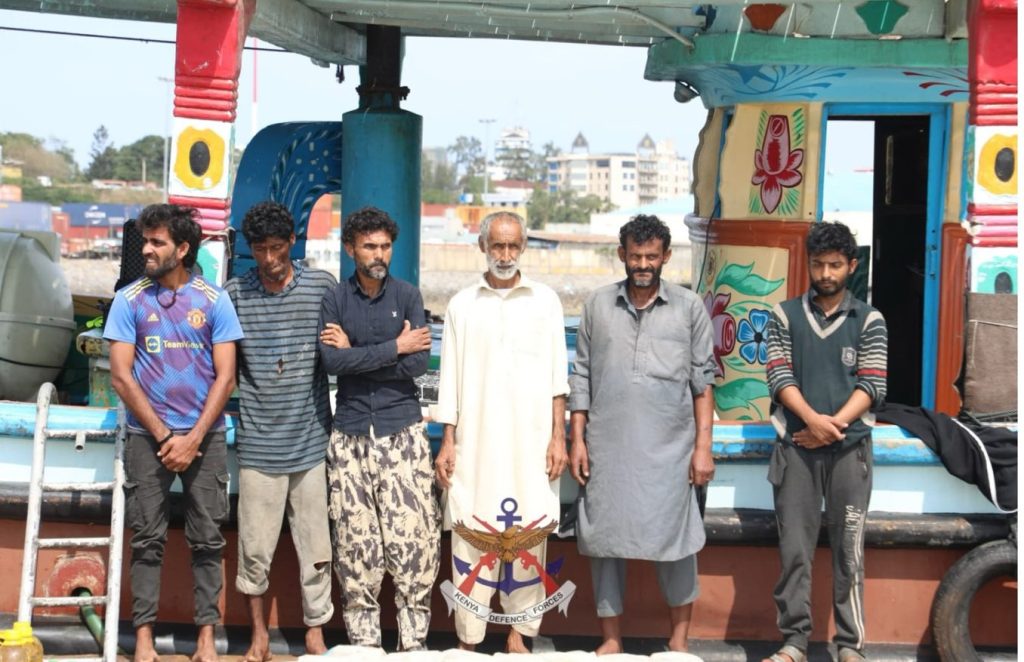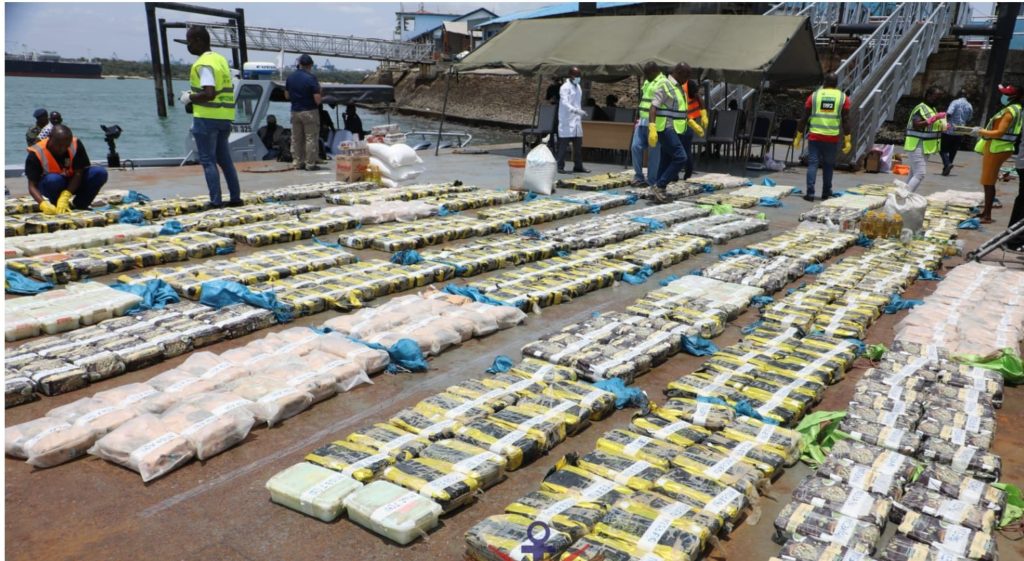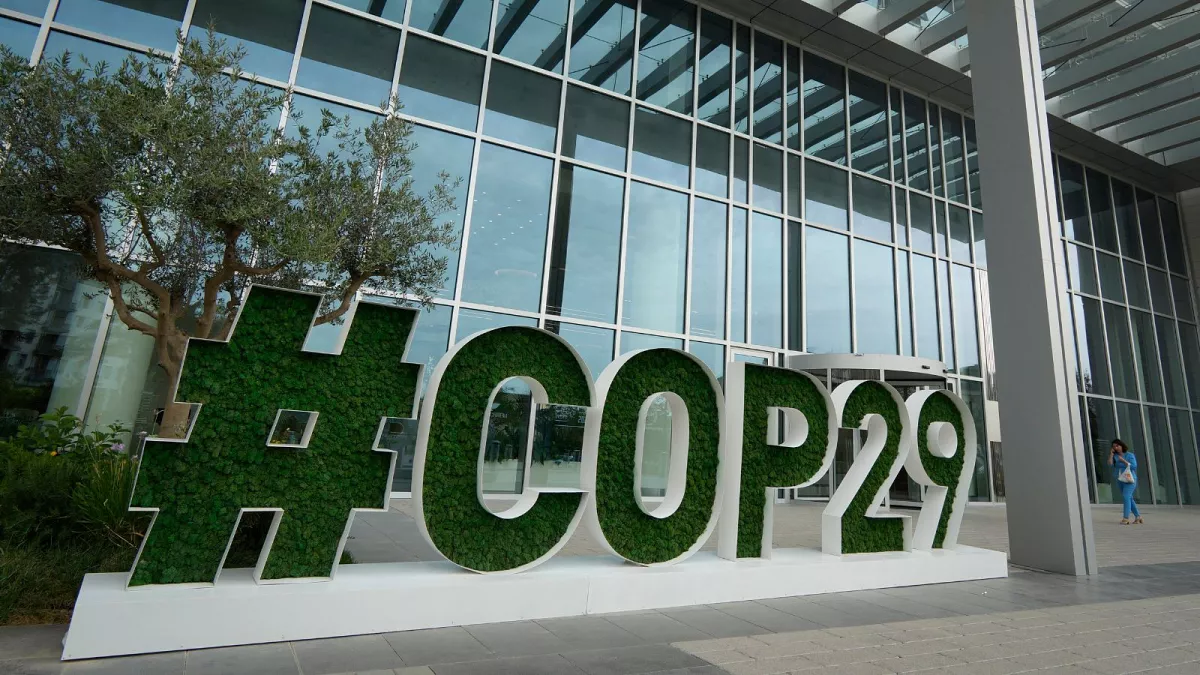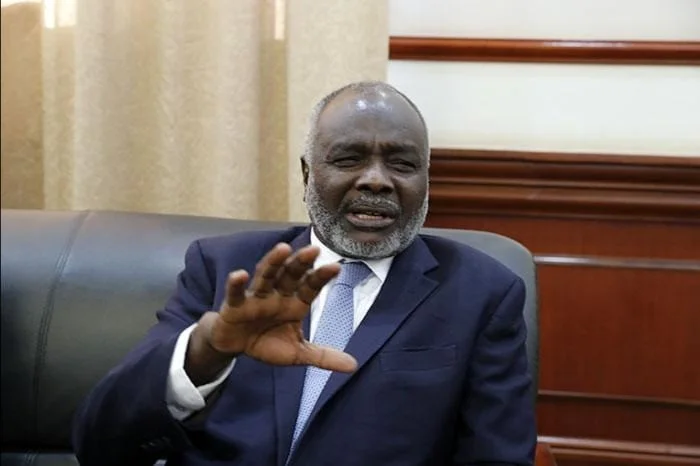SPACIAL REPORT
The Kenya Navy’s recent seizure of over a tonne of 98%-pure methamphetamine worth KSh 8 billion from six Iranian suspects on a flagless dhow 340 nautical miles off the Kenyan port of Mombasa, exposes the country’s escalating role as a global drug superhighway, demanding urgent multi-agency fortification of maritime, port, and airport defences before syndicates choke regional stability
To unlock the full article:
Choose one of the options below:
- Ksh 10 – This article only
- Ksh 300 – Monthly subscription
- Ksh 2340 – Yearly subscription (10% off)
By The Weekly Vision Investigations
The recent interception of 769 packets of a crystal substance weighing 1,024 kilogrammes, later confirmed to be methamphetamine, and the arrest of six Iranian nationals aboard a flagless vessel in the Indian Ocean, have once again spotlighted East Africa, particularly Kenya, as a major route for international drug trafficking.
The vessel was intercepted by the Kenya Navy on 31 October, approximately 340 nautical miles east of Mombasa, following intelligence shared between the Regional Narcotics Interagency Fusion Cell (RNIFC) in Bahrain and the Regional Coordination Operations Centre (RCOC) in Seychelles. Three days later, the vessel was brought to Mombasa, where a multi-agency coordination centre was established under the chairmanship of the Deputy Commander of the Kenya Navy, Brigadier Sankale Kiswaa.

Forensic analysis by the Government Chemist confirmed the substance to be methamphetamine with a purity level of 98%. Experts estimate the haul to be worth over KSh 8 billion (US$63 million). In its advisory and mentoring capacity, the International Criminal Police Organisation (INTERPOL) played a central role in overseeing search operations and ensuring rigorous crime scene management to support future judicial proceedings.
INTERPOL also coordinated operational support from the US Naval Criminal Investigative Service (NCIS), which deployed two officials to assist with the search and communication with the crew. According to INTERPOL, the operation underscores the critical importance of international cooperation and intelligence sharing in combating maritime drug trafficking and strengthening regional security across the Indian Ocean.
It notes that in recent years, the East Africa, Southern Africa and Indian Ocean (EA–SA–IO) regions have witnessed an increase in criminal maritime activity. “Despite international and regional efforts to enhance maritime cooperation, countries in these regions still face piracy and armed robbery, drug trafficking, smuggling of small arms, light weapons and endangered species, human trafficking, illegal fishing, and terrorism targeting port infrastructure,” INTERPOL said.

Beyond security implications, INTERPOL warns that these illicit activities undermine socio-economic and political stability in affected countries. A report by the United Nations Office on Drugs and Crime (UNODC), presented at the 32nd Meeting of Heads of National Drug Law Enforcement Agencies in Vienna, Austria, in October 2024, confirmed that heroin trafficking along the southern route remains a defining feature of the East African drug landscape. Maritime shipments continue to arrive along the coasts of Kenya, Mozambique, and Seychelles.
A record seizure by Tanzanian authorities in December 2024 uncovered more than 2.1 tonnes of heroin, confirming the country’s strategic role as both an entry point and redistribution hub. In early 2025, maritime interdictions by regional and international actors, including the Armed Forces in the Southern Indian Ocean Zone (FAZSOI) and the Seychelles Coast Guard, resulted in multiple high-volume seizures, including 1,069 kilogrammes of heroin off Seychelles in March, 714 kilogrammes in Mozambique in May, and 283 kilogrammes off Seychelles in October.
“Kenya and Uganda continued to serve as transit corridors,” the UNODC report adds, “with multiple seizures recorded in air cargo, fast parcels and passenger luggage at Entebbe and Nairobi airports.” Heroin-filled pellets destined for Europe were intercepted throughout 2024 by UNODC-supported units in Uganda, while in Kenya, heroin was found in outbound parcels bound for Australia, Canada, and Italy.
The report also highlights the connection between the regional heroin trade and West African criminal syndicates, who collaborate with local organised crime groups operating within ports and airports.
The UNODC notes that East Africa’s role in the global cocaine trade expanded significantly in 2024.
Mozambique emerged as a key maritime entry point, with a one-tonne shipment of cocaine from Brazil disguised as candy intercepted in June, and another 573 kilogrammes from India seized in November at the Port of Maputo, concealed in jerrycans and declared as sanitary wares.
These incidents illustrate the growing use of containerised shipping and multimodal logistics chains, with drugs offloaded along the northern coast, particularly in Pemba, and trafficked onwards to Kenya, Madagascar, and Malawi. At the same time, Addis Ababa’s Bole International Airport remains a major air trafficking hub, with Ethiopian law enforcement reporting several cocaine seizures in 2024, including the arrest of a South African courier carrying 13 kilogrammes in October.
After 687.76 kilogrammes of methamphetamine were seized at Tanzania’s Tanga Port in November 2024, alongside containers bearing traces of fentanyl, regional authorities reaffirmed East Africa’s growing role as a redistribution hub for methamphetamine trafficked from the Makran Coast, between Iran and Pakistan.
Further maritime seizures in Mozambique (472 kg in February and 597 kg in October) and Seychelles (722 kg in November) reinforced the regional scale of methamphetamine flows via maritime routes. These shipments, often landed by dhow in Comoros, Kenya and Seychelles, are increasingly linked to onward trafficking to Europe, Australia and New Zealand, reflecting a diversification of consumer markets.
Jomo Kenyatta International Airport (JKIA) in Nairobi, where UNODC has been conducting capacity-building for passenger and cargo control, remains a critical node in air parcel trafficking. In 2024, authorities noted a spike in seizures of methamphetamine, tramadol, ketamine, and other controlled substances. In April 2024, 6.4 kilogrammes of crystal methamphetamine sent from Uganda were seized en route to Indonesia, while several November seizures involved parcels bound for the Philippines and New Zealand.
“These cases point to Kenya’s expanding role as a repackaging and export hub for West and Southern African markets, utilising air cargo, courier and postal networks,” the report states. JKIA was recently thrust into the spotlight when Jesse Da Mata Dos Santos, a British national, was arrested at Heathrow Airport, London, with 20 kilogrammes of cocaine, having passed through JKIA despite stringent checks. This incident raised suspicions of collusion between traffickers and airport security and immigration personnel.
Subsequently, the Directorate of Criminal Investigations (DCI) arrested four men suspected of involvement in the network. Among them was the alleged ringleader, Rishad Abdulrahim Sheikh, a dual Kenyan-British citizen, and his cousin Hajinur Yussuf Mohamed, arrested in Mombasa’s Nyali Centre. Two others, Muamar Mutua Mohammed and Adam Omari, were arrested in Nairobi.
During the Nairobi raid, detectives recovered 750 grammes of cocaine valued at KSh 2.9 million, along with packaging materials used for concealing drugs. The DCI said the suspects were linked to Dos Santos’s network. To counter such maritime and air-based crimes, INTERPOL, with financial assistance from the United States and the European Union, has been implementing Project Compass and the Port Security Project.
Project Compass, funded by the US Department of State’s Bureau of International Narcotics and Law Enforcement Affairs (INLEA) to the tune of KSh 532 million (US$3.5 million), seeks to enhance maritime crime investigation in ten countries, including Kenya, Tanzania, Seychelles, and Somalia.
The Port Security Project, funded by the EU with KSh 1 billion (US$7.8 million), focuses on protecting critical maritime facilities, enhancing security coordination, and improving capacity to monitor the growing volume of cargo passing through regional ports. Officials credit these initiatives for the successful seizure of the methamphetamine consignment and the arrest of the six Iranian suspects, who remain in custody for 30 days pending further investigations.
The multi-agency operation involved the Kenya Coast Guard Service (KCGS), Kenya Maritime Authority (KMA), Kenya Ports Authority (KPA), Office of the Director of Public Prosecutions (ODPP), Port Health Services (PHS), DCI’s Anti-Narcotics Unit (ANU), Sensitive Investigations Unit (SIU), Directorate of Immigration Services (DIS), and the National Authority for the Campaign Against Alcohol and Drug Abuse (NACADA).
Despite multiple regional and international interventions, Kenya’s geographical position, developed transport infrastructure, and porous borders continue to make it a strategic hub for global drug syndicates. The latest interdictions underscore not only the scale of the threat but also the urgent need for tighter oversight at sea, in ports, and at airports.
[/full]




